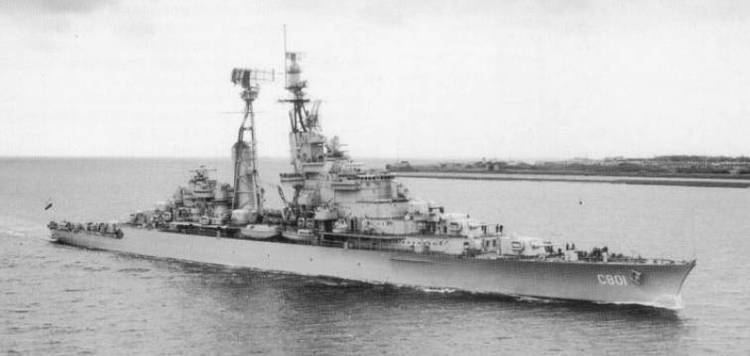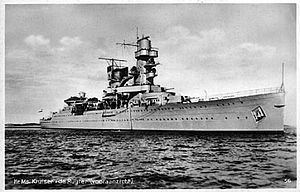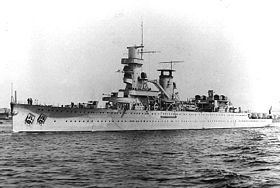Name De Ruyter Commissioned 3 October 1936 Construction started 16 September 1933 Length 171 m | Laid down 16 September 1933 Launched 11 March 1935 Beam 16 m | |
 | ||
Displacement 6,545 long tons (6,650 t) (standard) | ||
Hnlms de ruyter 1935
HNLMS De Ruyter (Dutch: Hr.Ms. De Ruyter) was a unique light cruiser of the Royal Netherlands Navy. She was originally designed as a 5,000-long-ton (5,100 t) ship with a lighter armament due to financial problems and the pacifist movement. Later in the design stage, an extra gun turret was added and the armor was improved. She was the seventh ship of the Dutch Navy to be named after Admiral Michiel Adriaenszoon de Ruyter.
Contents

De Ruyter was laid down on 16 September 1933 at the Wilton-Fijenoord dockyard in Schiedam and commissioned on 3 October 1936, commanded by Captain A. C. van der Sande Lacoste. She was sunk in the Battle of the Java Sea in 1942.

Design

De Ruyter was designed during the Great Depression, which, in addition to being a period of economical depression, was also a period in which pacifism was widespread in the Netherlands. For these reasons, the design was officially called a flottieljeleider (flotilla leader) instead of a cruiser, and every effort was made to cut costs.

Its function was to aid the two existing cruisers of the Java class in the defence of the Dutch East Indies; the idea was that with three cruisers, there would always be two cruisers available, even if one cruiser had to be repaired.

However, due to the cost-cutting policy that went into her design, De Ruyter was not quite up to her task. Her main battery (7 × 150 mm guns) was underpowered in comparison to other light cruisers of the time (for example the British Leander class), and the class had inadequate armour as well and lacked long range anti-aircraft guns. However, her fire control system was excellent.
Service history
During World War II, De Ruyter saw repeated action in the Dutch East Indies in fruitless attempts to ward off the Japanese invasion. She was damaged by air attack in the battle of Bali Sea on 4 February 1942, but not seriously. She fought in the battle of Badung Strait on 18 February.
In the Battle of the Java Sea on 27 February, De Ruyter was the flagship of the Dutch Rear-Admiral Karel Doorman, with his flag captain Eugène Lacomblé (who had previously served on board the ship as a lieutenant). Off the north coast off Java on the evening of the 27th the remains of the ABDA fleet was surprised by the Japanese heavy cruisers Nachi and Haguro. De Ruyter was hit by a single Type 93 torpedo fired by Haguro at about 23:30, and she sank at about 02:30 the next morning with the loss of 345 men, including Admiral Doorman and Captain Lacomblé. Her wreck was found after the war (in 2002) and declared a war grave, with the ship's two bells—one now in the Kloosterkerk in the Hague—being recovered. The wrecks of De Ruyter, HNLMS Java, and HNLMS Kortenaer were found by amateur divers in 2002.
In 2016 it was discovered that the wrecks of De Ruyter and Java, and much of Kortenaer had disappeared from the seabed, although their imprints on the ocean floor remained. Over 100 ships and submarines of various countries sank during the war in the seas around Indonesia, Singapore and Malaysia; many are designated as war graves. There is known to be illegal scavenging of these wrecks, often using explosives; the Netherlands Defence Ministry suggested that De Ruyter, Java, and Kortenaer may have been illegally salvaged.
